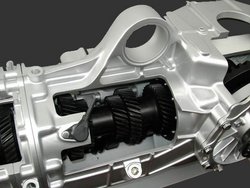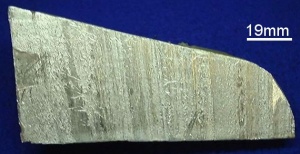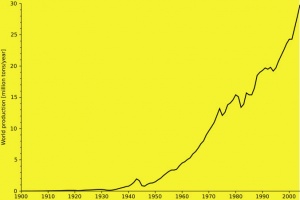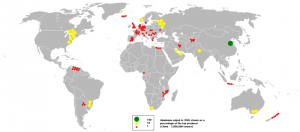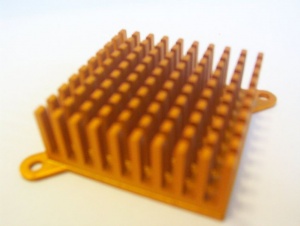Aluminium
SPELLING OF ALUMINIUM - Please see the talk page, this article is written in British English and so 'ium' should be used.
Aluminium (IPA: /ˌæljʊˈmɪniəm/, /ˌæljəˈmɪniəm/) or aluminum (IPA: /əˈluːmɪnəm/, see the "spelling" section below) is a silvery and ductile member of the poor metal group of chemical elements. It has the symbol Al; its atomic number is 13.
Aluminium is found primarily in bauxite ore and is remarkable for its ability to resist corrosion (due to the phenomenon of passivation) and its light weight. The metal is used in many industries to manufacture a large variety of products and is very important to the world economy. Structural components made from aluminium and its alloys are vital to the aerospace industry and very important in other areas of transportation and building.
Properties
Aluminium is a soft, lightweight metal normally with a dull gray appearance caused by a thin layer of oxidation that forms quickly when the metal is exposed to air. Aluminium oxide has a higher melting point than pure aluminium. Aluminium is nontoxic (as the metal), nonmagnetic, and nonsparking. It has a tensile strength of about 49 megapascals (MPa) in a pure state and 400 MPa as an alloy. Aluminium is about one-third as dense as steel or copper; it is malleable, ductile, and easily machined and cast. It has excellent corrosion resistance and durability because of the protective oxide layer.
Aluminium is one of the few metals which retain full silvery reflectance, even in finely powdered form, which makes it a very important component of silver paints.
Aluminium's crystal structure is an FCC structure, hence the high ductility of the pure metal.
Aluminium mirror finish has the highest reflectance of any metal in the 200–400 nm (UV) and the 3000–10000 nm (far IR) regions, while in the 400–700 nm visible range it is slightly outdone by silver and in the 700–3000 (near IR) by silver, gold, and copper. It is the second-most malleable metal (after gold) and the sixth-most ductile. Aluminium is a good thermal and electrical conductor, by weight better than copper. Aluminium is capable of being a superconductor, with a superconducting critical temperature of 1.2 Kelvin.
Applications
General use
Whether measured in terms of quantity or value, the global use of aluminium exceeds that of any other metal except iron, and it is important in virtually all segments of the world economy.
Relatively pure aluminium is encountered only when corrosion resistance and/or workability is more important than strength or hardness. Pure aluminium serves as an excellent reflector (approximately 99%) of visible light and a good reflector (approximately 95%) of infrared. A thin layer of aluminium can be deposited onto a flat surface by chemical vapour deposition or chemical means to form optical coatings and mirrors. These coatings form an even thinner layer of protective aluminium oxide that does not deteriorate, as silver coatings do. Nearly all modern mirrors are made using a thin coating of aluminium on the back surface of a sheet of float glass. Telescope mirrors are also made with aluminium, but are front coated to avoid internal reflections, refraction, and transparency losses. These first surface mirrors are more susceptible to damage than household back-surface mirrors.
Pure aluminium has a low tensile strength, but when combined with thermo-mechanical processing, aluminium alloys display a marked improvement in mechanical properties, especially when tempered. Aluminium alloys form vital components of aircraft and rockets as a result of their high strength-to-weight ratio. Aluminium readily forms alloys with many elements such as copper, zinc, magnesium, manganese and silicon (e.g., duralumin). Today, almost all bulk metal materials that are referred to loosely as "aluminium," are actually alloys. For example, the common aluminium foils are alloys of 92% to 99% aluminium.
Some of the many uses for aluminium metal are in:
- Transportation (automobiles, aircraft, trucks, railroad cars, marine vessels, bicycles etc.)
- Packaging (cans, foil, etc.)
- Water treatment
- Treatment against fish parasites such as Gyrodactylus salaris.
- Construction (windows, doors, siding, building wire, etc.)
- Cooking utensils
- Electrical transmission lines for power distribution
- MKM steel and Alnico magnets
- Super purity aluminium (SPA, 99.980% to 99.999% Al), used in electronics and CDs.
- Heat sinks for electronic appliances such as transistors and CPUs.
- Powdered aluminium is used in paint, and in pyrotechnics such as solid rocket fuels and thermite.
- In the blades of prop swords and knives used in stage combat.
Aluminium Compounds
- Aluminium ammonium sulfate ([Al(NH4)](SO4)2) is used: as a mordant, in water purification and sewage treatment, in paper production, as a food additive, and in leather tanning.
- Aluminium acetate is a salt used in solution as an astringent.
- Aluminium chloride (AlCl3) is used: in paint manufacturing, in antiperspirants, in petroleum refining and in the production of synthetic rubber.
- Aluminium chlorohydride is used as an antiperspirant and as an anhidrotic in the treatment of hyperhidrosis.
- Aluminium fluorosilicate (Al2(SiF6)3) is used in the production of synthetic gemstones, glass and ceramic.
- Aluminium hydroxide (Al(OH)3) is used: as an antacid, as a mordant, in water purification, in the manufacture of glass and ceramic and in the waterproofing of fabrics.
- Aluminium oxide (Al2O3, alumina, is found naturally as corundum (rubies and sapphires), emery, and is used in glass making. Synthetic ruby and sapphire are used in lasers for the production of coherent light.
- Aluminium phosphate (AlPO4) is used in the manufacture: of glass and ceramic, pulp and paper products, cosmetics, paints and varnishes and in making dental cement.
- Aluminium sulphate (Al2(SO4)3) is used: in the manufacture of paper, as a mordant, in a fire extinguisher, in water purification and sewage treatment, as a food additive, in fireproofing, and in leather tanning.
- In many vaccines, certain aluminium salts serve as an immune adjuvant (immune response booster) to allow the protein in the vaccine to achieve sufficient potency as an immune stimulant.
Engineering use
Template:Main Aluminium alloys with a wide range of properties are used in engineering structures. Alloy systems are classified by a number system (ANSI) or by names indicating their main alloying constituents (DIN and ISO). For more, see the main article referenced.
Aluminium is used extensively in many places due to its high strength to weight ratio. However, a designer used to working with steel will find aluminium less well-behaved in terms of flexibility. The problems may often be addressed by redesigning parts dimensionally specifically to address issues of stiffness. For instance by increasing the second moment of area for a pipe or I-beam, an aluminium design can be made both stiffer and lighter than a traditional design.
The strength and durability of aluminium alloys varies widely, not only as a result of the components of the specific alloy, but also as a result of heat treatments and manufacturing processes. A lack of knowledge of these aspects has from time to time led to improperly designed structures and gained aluminium a bad reputation. (See main article)
One important structural limitation of aluminium alloys is their fatigue strength. Unlike steels, aluminium alloys have no well defined fatigue limit, meaning that fatigue failure will eventually occur under even very small cyclic loadings. This implies that engineers must assess these loads and design for a fixed life rather than an infinite life.
Another important property of aluminium alloys is their sensitivity to heat. Workshop procedures involving heating are complicated by the fact that aluminium, unlike steel, will melt without first glowing red. Forming operations where a blow torch is used therefore requires some expertise, since no visual signs reveal how close the material is to melting. Aluminium alloys, like all structural alloys, also are subject to internal stresses following heating operations such as welding and casting. The problem with aluminium alloys in this regard is their low melting point, which make them more susceptible to distortions from thermally induced stress relief. Controlled stress relief can be done during manufacturing by heat-treating the parts in an oven, followed by gradual cooling - in effect annealing the stresses.
The low melting point of aluminium alloys has not precluded their use in rocketry; even for use in constructing combustion chambers where gases can reach 3500 K. The Agena upper stage engine used a regeneratively cooled aluminium design for some parts of the nozzle, including the thermally critical throat region; in fact the extremely high thermal conductivity of aluminium prevented the throat from reaching the melting point even under massive heat flux, resulting in a reliable and lightweight component.
Household wiring
Aluminium has about 65% of the conductivity of copper, the traditional household wiring material. In the 1960s aluminium was considerably cheaper than copper, and so was introduced for household electrical wiring in the United States, even though many fixtures had not been designed to accept aluminium wire. However, in some cases the greater coefficient of thermal expansion of aluminium causes the wire to expand and contract relative to the dissimilar metal screw connection, eventually loosening the connection. Also, pure aluminium has a tendency to "creep" under steady sustained pressure (to a greater degree as the temperature rises), again loosening the connection. Finally, Galvanic corrosion from the dissimilar metals increased the electrical resistance of the connection.
All of this resulted in overheated and loose connections, and this in turn resulted in some fires. Builders then became wary of using the wire, and many jurisdictions outlawed its use in very small sizes, in new construction. Eventually, newer fixtures were introduced with connections designed to avoid loosening and overheating. At first they were marked "Al/Cu", but they now bear a "CO/ALR" coding. In older assemblies, workers forestall the heating problem using a properly-done crimp of the aluminium wire to a short "pigtail" of copper wire. Today, new alloys, designs, and methods are used for aluminium wiring in combination with aluminium terminations.
History
Ancient Greeks and Romans used aluminium salts as dyeing mordants and as astringents for dressing wounds; alum is still used as a styptic. In 1761 Guyton de Morveau suggested calling the base alum alumine. In 1808, Humphry Davy identified the existence of a metal base of alum, which he at first named alumium and later aluminum (see Spelling section, below).
Friedrich Wöhler is generally credited with isolating aluminium (Latin alumen, alum) in 1827 by mixing anhydrous aluminium chloride with potassium. The metal, however, had indeed been produced for the first time two years earlier — but in an impure form — by the Danish physicist and chemist Hans Christian Ørsted. Therefore, Ørsted can also be listed as the discoverer of the metal. Further, Pierre Berthier discovered aluminium in bauxite ore and successfully extracted it. The Frenchman Henri Etienne Sainte-Claire Deville improved Wöhler's method in 1846 and described his improvements in a book in 1859, chief among these being the substitution of sodium for the considerably more expensive potassium.
(Note: The title of Deville's book is "De l'aluminium, ses propriétés, sa fabrication" (Paris, 1859). It was quite likely that Deville also thought of the idea of the electrolysis of aluminium oxide dissolved in cryolite. However, Charles Martin Hall and Paul Heroult might have developed the more practical process after Deville.)
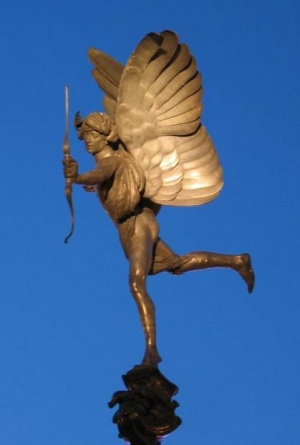
Aluminium was selected as the material to be used for the apex of the Washington Monument, at a time when one ounce (30 grams) cost twice the daily wages of a common worker in the project; aluminium was a semiprecious metal at that time.
The American Charles Martin Hall of Oberlin, Ohio applied for a patent in 1886 for an electrolytic process to extract aluminium using the same technique that was independently being developed by the Frenchman Paul Héroult in Europe. The invention of the Hall-Héroult process in 1886 made extracting aluminium from minerals cheaper, and is now the principal method in common use throughout the world. The Hall-Heroult process cannot produce Super Purity Aluminium directly. Upon approval of his patent in 1889, Hall, with the financial backing of Alfred E. Hunt of Pittsburgh, PA, started the Pittsburgh Reduction Company, renamed to Aluminum Company of America in 1907, later shortened to Alcoa. Germany became the world leader in aluminium production soon after Adolf Hitler's rise to power. By 1942, however, new hydroelectric power projects such as the Grand Coulee Dam gave the United States something Nazi Germany could not compete with, provided them with sufficient generating capacity to produce enough aluminium to manufacture sixty thousand warplanes in four years.
Aluminium metal production and refinement
Although aluminium is the most abundant metallic element in Earth's crust (believed to be 7.5% to 8.1%), it is very rare in its free form, occurring in oxygen-deficient environments such as volcanic mud, and it was once considered a precious metal more valuable than gold. Napoleon III, Emperor of France, is reputed to have given a banquet where the most honoured guests were given aluminium utensils, while the other guests had to make do with gold ones. Aluminium has been produced in commercial quantities for just over 100 years.
Aluminium is a reactive metal that is difficult to extract from ore, aluminium oxide (Al2O3). Direct reduction — with carbon, for example — is not economically viable since aluminium oxide has a melting point of about 2,000 °C. Therefore, it is extracted by electrolysis; that is, the aluminium oxide is dissolved in molten cryolite and then reduced to the pure metal. By this process, the operational temperature of the reduction cells is around 950 to 980 °C. Cryolite is found as a mineral in Greenland, but in industrial use it has been replaced by a synthetic substance. Cryolite is a mixture of aluminium, sodium, and calcium fluorides: (Na3AlF6). The aluminium oxide (a white powder) is obtained by refining bauxite in the Bayer process. (Previously, the Deville process was the predominant refining technology.)
The electrolytic process replaced the Wöhler process, which involved the reduction of anhydrous aluminium chloride with potassium. Both of the electrodes used in the electrolysis of aluminium oxide are carbon. Once the ore is in the molten state, its ions are free to move around. The reaction at the cathode — the negative terminal — is
- Al3+ + 3 e− → Al
Here the aluminium ion is being reduced (electrons are added). The aluminium metal then sinks to the bottom and is tapped off.
At the positive electrode (anode), oxygen is formed:
- 2 O2− → O2 + 4 e−
This carbon anode is then oxidised by the oxygen, releasing carbon dioxide. The anodes in a reduction cell must therefore be replaced regularly, since they are consumed in the process:
- O2 + C → CO2
Unlike the anodes, the cathodes are not oxidised because there is no oxygen present at the cathode. The carbon cathode is protected by the liquid aluminium inside the cells. Nevertheless, cathodes do erode, mainly due to electrochemical processes. After five to ten years, depending on the current used in the electrolysis, a cell has to be rebuilt because of cathode wear.
Aluminium electrolysis with the Hall-Héroult process consumes a lot of energy, but alternative processes were always found to be less viable economically and/or ecologically. The world-wide average specific energy consumption is approximately 15±0.5 kilowatt-hours per kilogram of aluminium produced from alumina. (52 to 56 MJ/kg). The most modern smelters reach approximately 12.8 kW·h/kg (46.1 MJ/kg). Reduction line current for older technologies are typically 100 to 200 kA. State-of-the-art smelters operate with about 350 kA. Trials have been reported with 500 kA cells.
Recovery of the metal via recycling has become an important facet of the aluminium industry. Recycling involves melting the scrap, a process that uses only five percent of the energy needed to produce aluminium from ore. Recycling was a low-profile activity until the late 1960s, when the growing use of aluminium beverage cans brought it to the public consciousness.
Electric power represents about 20% to 40% of the cost of producing aluminium, depending on the location of the smelter. Smelters tend to be situated where electric power is both plentiful and inexpensive, such as South Africa, the South Island of New Zealand, Australia, the People's Republic of China, the Middle East, Russia, Quebec and British Columbia in Canada, and Iceland.
In 2005, the People's Republic of China was the top producer of aluminium with almost one-fifth world share followed by Russia, Canada and USA reports the British Geological Survey.
Over the last 50 years, Australia has become a major producer of bauxite ore and a major producer and exporter of alumina. Australia produced 62 million tonnes of bauxite in 2005. The Australian deposits have some refining problems, some being high in silica but have the advantage of being shallow and relatively easy to mine.
Isotopes
Aluminium has nine isotopes, whose mass numbers range from 23 to 30. Only 27Al (stable isotope) and 26Al (radioactive isotope, t1/2 = 7.2 × 105 y) occur naturally, however 27Al has a natural abundance of 99.9+ %. 26Al is produced from argon in the atmosphere by spallation caused by cosmic-ray protons. Aluminium isotopes have found practical application in dating marine sediments, manganese nodules, glacial ice, quartz in rock exposures, and meteorites. The ratio of 26Al to 10Be has been used to study the role of transport, deposition, sediment storage, burial times, and erosion on 105 to 106 year time scales.
Cosmogenic 26Al was first applied in studies of the Moon and meteorites. Meteorite fragments, after departure from their parent bodies, are exposed to intense cosmic-ray bombardment during their travel through space, causing substantial 26Al production. After falling to Earth, atmospheric shielding protects the meteorite fragments from further 26Al production, and its decay can then be used to determine the meteorite's terrestrial age. Meteorite research has also shown that 26Al was relatively abundant at the time of formation of our planetary system. Most meteoriticists believe that the energy released by the decay of 26Al was responsible for the melting and differentiation of some asteroids after their formation 4.55 billion years ago.
Clusters
In the journal Science of 14 January 2005 it was reported that clusters of 13 aluminium atoms (Al13) had been made to behave like an iodine atom; and, 14 aluminium atoms (Al14) behaved like an alkaline earth atom. The researchers also bound 12 iodine atoms to an Al13 cluster to form a new class of polyiodide. This discovery is reported to give rise to the possibility of a new characterisation of the periodic table: superatoms. The research teams were led by Shiv N. Khanna (Virginia Commonwealth University) and A. Welford Castleman Jr (Penn State University).
Precautions
Aluminium is a neurotoxin that alters the function of the blood-brain barrier. It is one of the few abundant elements that appears to have no beneficial function to living cells. A small percent of people are allergic to it — they experience contact dermatitis from any form of it: an itchy rash from using styptic or antiperspirant products, digestive disorders and inability to absorb nutrients from eating food cooked in aluminium pans, and vomiting and other symptoms of poisoning from ingesting such products as Amphojel, and Maalox (antacids). In other people, aluminium is not considered as toxic as heavy metals, but there is evidence of some toxicity if it is consumed in excessive amounts. The use of aluminium cookware, popular because of its corrosion resistance and good heat conduction, has not been shown to lead to aluminium toxicity in general. Excessive consumption of antacids containing aluminium compounds and excessive use of aluminium-containing antiperspirants are more likely causes of toxicity. In research published in the Journal of Applied Toxicology, Dr. Philippa D. Darby of the University of Reading has shown that aluminium salts increase estrogen-related gene expression in human breast cancer cells grown in the laboratory. These salts' estrogen-like effects have lead to their classification as a metalloestrogen.
It has been suggested that aluminium is a cause of Alzheimer's disease, as some brain plaques have been found to contain the metal. Research in this area has been inconclusive; aluminium accumulation may be a consequence of the Alzheimer's damage, not the cause. In any event, if there is any toxicity of aluminium it must be via a very specific mechanism, since total human exposure to the element in the form of naturally occurring clay in soil and dust is enormously large over a lifetime.
Mercury applied to the surface of an aluminium alloy can damage the protective oxide surface film by forming amalgam. This may cause further corrosion and weakening of the structure. For this reason, mercury thermometers are not allowed on many airliners, as aluminium is used in many aircraft structures.
Powdered aluminium can react with Fe2O3 to form Fe and Al2O3. This mixture is known as thermite, which burns with a high energy output. Thermite can be produced inadvertently during grinding operations, but the high ignition temperature makes incidents unlikely in most workshop environments.
Aluminium and plants (Phytoremediation)
Aluminium is primary among the factors that contribute to the loss of plant production on acid soils. Although it is generally harmless to plant growth in pH-neutral soils, the concentration in acid soils of toxic Al3+ cations increases and disturbs root growth and function.
Wheat's adaptation to allow aluminium tolerance is such that the aluminium induces a release of organic compounds that bind to the harmful aluminium cations. Sorghum is believed to have the same tolerance mechanism. The first gene for aluminium tolerance has been identified in wheat. A group in the US Department of Agriculture showed that sorghum's aluminium tolerance is controlled by a single gene, as for wheat. This is not the case in all plants.
Spelling
Etymology/nomenclature history
The earliest citation given in the Oxford English Dictionary for any word used as a name for this element is alumium, which Humphry Davy employed in 1808 for the metal he was trying to isolate electrolytically from the mineral alumina. The citation is from his journal Philosophical Transactions: "Had I been so fortunate as..to have procured the metallic substances I was in search of, I should have proposed for them the names of silicium, alumium, zirconium, and glucium."
By 1812, Davy had settled on aluminum, which, as other sources note,Template:Fact matches its Latin root. He wrote in the journal Chemical Philosophy: "As yet Aluminum has not been obtained in a perfectly free state." But the same year, an anonymous contributor to the Quarterly Review, a British political-literary journal, objected to aluminum and proposed the name aluminium, "for so we shall take the liberty of writing the word, in preference to aluminum, which has a less classical sound."
The -ium suffix had the advantage of conforming to the precedent set in other newly discovered elements of the period: potassium, sodium, magnesium, calcium, and strontium (all of which Davy had isolated himself). Nevertheless, -um spellings for elements were not unknown at the time, as for example platinum, known to Europeans since the 16th century, molybdenum, discovered in 1778, and tantalum, discovered in 1802.
Americans adopted -ium for most of the 19th century, with aluminium appearing in Webster's Dictionary of 1828. In 1892, however, Charles Martin Hall used the -um spelling in an advertising handbill for his new electrolytic method of producing the metal, despite his constant use of the -ium spelling in all the patents he filed between 1886 and 1903. It has consequently been suggested that the spelling on the flier was a simple spelling mistake. Hall's domination of production of the metal ensured that the spelling aluminum became the standard in North America; the Webster Unabridged Dictionary of 1913, though, continued to use the -ium version.
In 1926, the American Chemical Society officially decided to use aluminum in its publications; American dictionaries typically label the spelling aluminium as a British variant.
Present-day spelling
In the UK and other countries using British spelling, only aluminium is used. In the United States, the spelling aluminium is largely unknown, and the spelling aluminum predominates. The Canadian Oxford Dictionary prefers aluminum, whereas the Australian Macquarie Dictionary prefers aluminium.
In other English-speaking countries, the spellings (and associated pronunciations) aluminium and aluminum are both in common use in scientific and nonscientific contexts. The spelling in virtually all other languages is analogous to the -ium ending. (See the box in the first column of this page for specific languages.)
The International Union of Pure and Applied Chemistry (IUPAC) adopted aluminium as the standard international name for the element in 1990, but three years later recognized aluminum as an acceptable variant. Hence their periodic table includes both, but places aluminium first. IUPAC officially prefers the use of aluminium in its internal publications, although several IUPAC publications use the spelling aluminum.
Chemistry
Oxidation state one
In particular the temperatures in this section seem to be the subject of controversy.
- AlH is produced when aluminium is heated at 1500 °C in an atmosphere of hydrogen.
- Al2O is made by heating the normal oxide, Al2O3, with silicon at 1800 °C in a vacuum.
- Al2S can be made by heating Al2S3 with aluminium shavings at 1300 °C in a vacuum. It quickly disproportionates to the starting materials. The selenide is made in a parallel manner.
- AlF, AlCl and AlBr exist in the gaseous phase when the tri-halide is heated with aluminium.
Oxidation state two
- Aluminium monoxide, AlO, is present when aluminium powder burns in oxygen.
Oxidation state three
- Fajans rules show that the simple trivalent cation Al3+ is not expected to be found in anhydrous salts or binary compounds such as Al2O3. The hydroxide is a weak base and aluminium salts of weak acids, such as carbonate, can't be prepared. The salts of strong acids, such as nitrate, are stable and soluble in water, forming hydrates with at least six molecules of water of crystallization.
- Aluminium hydride, (AlH3)n, can be produced from trimethylaluminium and an excess of hydrogen. It burns explosively in air. It can also be prepared by the action of aluminium chloride on lithium hydride in ether solution, but cannot be isolated free from the solvent.
- Aluminium carbide, Al4C3 is made by heating a mixture of the elements above 1000 °C. The pale yellow crystals have a complex lattice structure, and react with water or dilute acids to give methane. The acetylide, Al2(C2)3, is made by passing acetylene over heated aluminium.
- Aluminium nitride, AlN, can be made from the elements at 800 °C. It is hydrolysed by water to form ammonia and aluminium hydroxide.
- Aluminium phosphide, AlP, is made similarly, and hydrolyses to give phosphine.
- Aluminium oxide, Al2O3, occurs naturally as corundum, and can be made by burning aluminium in oxygen or by heating the hydroxide, nitrate or sulfate. As a gemstone, its hardness is only exceeded by diamond, boron nitride, and carborundum. It is almost insoluble in water.
- Aluminium hydroxide may be prepared as a gelatinous precipitate by adding ammonia to an aqueous solution of an aluminium salt. It is amphoteric, being both a very weak acid, and forming aluminates with alkalis. It exists in various crystalline forms.
- Aluminium sulfide, Al2S3, may be prepared by passing hydrogen sulfide over aluminium powder. It is polymorphic.
- Aluminium iodide, (AlI3)2, is a dimer with applications in organic synthesis.
- Aluminium fluoride, AlF3, is made by treating the hydroxide with HF, or can be made from the elements. It consists of a giant molecule which sublimes without melting at 1291 °C. It is very inert. The other trihalides are dimeric, having a bridge-like structure.
- Aluminium fluoride/water complexes: When aluminium and fluoride are together in aqueous solution, they readily form complex ions such as AlF(H2O)5+2, AlF3(H2O)30, AlF6-3. Of these, AlF6-3 is the most stable. This is explained by the fact that aluminium and fluoride, which are both very compact ions, fit together just right to form the octahedral aluminium hexafluoride complex. When aluminium and fluoride are together in water in a 1:6 molar ratio, AlF6-3 is the most common form, even in rather low concentrations.
- Organo-metallic compounds of empirical formula AlR3 exist and, if not also giant molecules, are at least dimers or trimers. They have some uses in organic synthesis, for instance trimethylaluminium.
- Alumino-hydrides of the most electropositive elements are known, the most useful being lithium aluminium hydride, Li[AlH4]. It decomposes into lithium hydride, aluminium and hydrogen when heated, and is hydrolysed by water. It has many uses in organic chemistry, particularly as a reducing agent. The aluminohalides have a similar structure.
See also
- Aluminium alloy
- Aluminium battery
- Aluminium in Africa
- Beverage can
- Category:Aluminium compounds
- Category:Aluminium companies
- Aluminium foil
